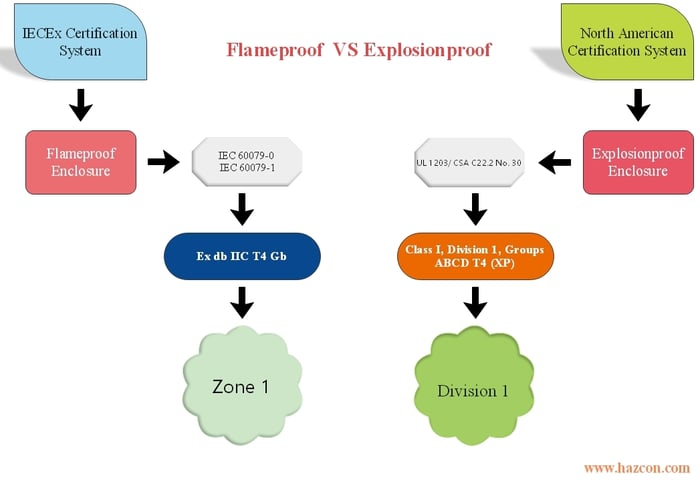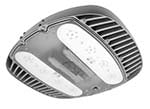Understanding the Differences Between the Protection Technique Known as "Explosion-proof" or "Flameproof"
This content is courtesy of the Hazloc Directory with who we are affiliated with.
Explosion Proof vs Flameproof
Some electrical devices, even when operating under normal conditions, can produce arcing and/or sparking. If such a device is installed in a hazardous location (where there are or can be ignitable gases or vapours), an explosion can result. One of the approaches used to protect electrical devices installed in such locations (HazLoc products) is based on the principle of containing an explosion, should one take place. There are two names given to this technique: “explosionproof” and “flameproof”.
This technique involves using an enclosure. Even if an explosion takes place within it, the enclosure prevents ignition and explosion from being transmitted to the area surrounding the enclosure – the area that contains flammable/ ignitable gases or vapours.
Although explosionproof and flameproof are similar, there are some differences. They are based on different certification systems (the first one being international and the other North American); they are therefore based on different Standards (IEC Standards vs. the North American Standards). They result in differences in the markings assigned to the product. Some of the compliance requirements are different.
It’s important to understand these differences if:
- You want to achieve Zone classification system certification through the IECEx Scheme.
- You want to achieve Class/division system certification through a North American certifying body so your product can be installed and used in in North America.
- You want to achieve Zone system certification through a North American certifying body so your product can be installed and used in Canada OR the United States in Zone classified areas.
- You aren’t sure about the equivalency of Standards related to explosionproof or flameproof in Canada, the US, and internationally.
- You want to certify your product to be installed and used anywhere in the world.
- You need to know what additional requirements may apply if you want your existing certification recognized elsewhere in the world.
Following is an explanation of the similarities and differences between explosionproof and flameproof. The differences may seem minor but are critical to manufacturers in the product design stage and when seeking certification.
Explosion Proof
The term “Explosion Proof” applies to HazLoc products approved by North American certification agencies using the Class/division system, for products to be used in North America.
Historically, the North American certification system is known for its use of a Class/Division classification system. Products to be installed in hazardous locations may be Class I, Division 1, for example. HazLoc products that are Class I Division 1 typically use the explosionproof protection technique. Products using the intrinsic safety or purging and pressurization Type X protection techniques can also get Class I, Division 1 certification.
Relevant Standards for Explosion Proof
Requirements for the “Explosion Proof” protection technique are documented in North American Standards, namely those developed by the Canadian Standards Association (CSA), Underwriters Laboratories (UL), FM Approvals (FM) and the American National Standards Institute (ANSI).
A product wanting to get a Class I, Division 1 marking using the explosionproof protection technique must comply with Standard UL 1203 for the US and CSA C22.2 No. 30 for Canada. Keep in mind that all electrical products in North America must also first comply with what are called general safety (also known as ordinary location) Standards. This is the one of the major requirements for obtaining a hazardous location certification for North America.
These two Standards also address the designation of gases into groups. The gas groups for Class I Division 1 are A, B, C, and D. Gas groups indicate how easily ignited the gases within that group are. Gases in group A (Acetylene) are the most ignitable.
And the North American Standards noted also address the Temperature Class (T-class) of the device: T6 to T1 with some sub-groups for each.
Flameproof
The term “flameproof” applies to HazLoc products certified as follows:
- By the International IEC Standards, based on the Zone system, for use internationally (but not in North America).
- By North American certification agencies, based on the Zone system, for products to be used in Canada or the US (the requirements differ).
Flameproof always applies to certifications using the Zone system. There are additional Standards specifically for electrical devices using the flameproof protection technique. They are as follows:
- IEC 60079-1, which covers the technical requirements of products seeking Ex db marking using the flameproof technique for IEC certification for use internationally (but not in North America).
- UL 60079-1, which covers the technical requirements of products seeking Zone-based certification from North American certification agencies for use in the US.
- CSA C22.2 No. 60079-1, which covers the certification requirements of products seeking Zone-based certification from North American certification agencies for use in Canada.
Under the Zone classification system, there are three gas groups: IIC, IIB and IIA. Similar to the Class/division system, the word “Group” refers to degree of risk of an explosion. In the Zone classification system, however, gas Group IIC is the most ignitable gas.

Differences in the Markings of Explosion proof vs Flameproof
Products that have been certified are given markings that are used on product nameplates, in product literature, and in installation manuals. Because explosion proof and flameproof are based on differing classification systems and Standards, the markings are naturally different as well.
Explosion proof Markings
The Explosionproof markings for products that comply with North American Standards, based on the Class/division system, include their Class and Division. The marking indicates the ignitability of the gas (the Gas Group), as well as the T-class of the electrical device.
Following is an example of a Class/division marking of a product that has been certified by a North American certification agency for use in North America. The “XP” indicates that the protection method used is explosionproof:
Class I, Division 1, Groups A, B, C, D; T4 (XP)
Flameproof Markings
The flameproof markings for products that comply with Zone system certification requirements vary, depending on where the certification was achieved (through IEC or in North America).
a) Markings for products whose Zone-based certification was achieved through IEC are shown in this example:
Ex db IIC T4 Gb
The Ex stands for hazardous location. The “db” refers to flameproof. IIC refers to the gas group (this could be II A, B or C). The T4 refers to the temperature class (it could be T1, 2, 3, 4, 5, or 6) and the Gb refers to the Equipment Protection Label, Gb is for Zone 1, (Ga is for Zone 0 and Gc is for Zone 2).
b) Markings for products whose certification was achieved in the US for use in the US are shown in this example:
Zone 1, AEx db IIC T4 Gb Or Class I, Zone 1, AEx db IIC T4 Gb
c) Markings for products whose certification was achieved in Canada for use in Canada are shown in this example:
Ex db IIC T4 Gb
Answers to Common Questions
1. Can a product with Zone 1, AEx db IIC T4 Gb marking or Ex db IIC T4 Gb marking (Zone marking for North America, as per CSA and UL Standards) be installed in Class I, Division 1?
A: No. In order to get a product installed in a Class I, Division 1 area, the product must comply with UL 1203 for installation in the US and CSA C22.2 No. 30 for installation in Canada. Given compliance with these standards, (also compliance with ordinary location standards,) then Class I, Division 1 marking can be obtained.
2. Can a product with Class I, Division 1 marking be installed in Zone 1 hazardous areas in North America?
A: Yes, it is allowed as long as the gas groups and temperature class are compatible. The marking will remain Zone 1, AEx db IIC T4 Gb, for example.
3. What is the best route for an IECEx approved product with a marking such as Ex db IIC T4 Gb (for example) to be approved for the North American market?
A: First, an IECEx certified product will need to comply with the general safety (also called ordinary location) Standards for North America. These Standards are for consideration of electrical shock and fire hazards.
Then, in order to get Zone marking for North America, the product must comply with North American national deviations as provided in UL 60079-1 and CSA 60079-1 Standards. The marking which results will be Zone marking for North America.
In order to get Class I, Division 1 marking for North America, the product must comply with UL 1203 and CSA C22.2 No. 30, Complying with IEC 60079-1 for flameproof enclosures does not guarantee that a product will meet the requirements of CSA C22.2 No. 30 and UL 1203 for Class I, Division 1.
Summary
The protection technique that involves containing an explosion may be called “explosionproof” or “flameproof”, depending on which classification system is involved. Although the international market for hazloc products is strong, based on a Zone system and supported by the Standard IEC 60079-1 for flameproof equipment, the North American market is also significant, supported by Standards in both Canada and the US for explosionproof devices. North America, which has traditionally used the Class/Division system of classification, has adopted new Standards based on the Zone system, which appear to mirror their international counterparts. Be aware, however, that there are additional requirements, known as national deviations, between Standards (CSA C22.2 No. 60079-1 versus IEC 60079-1, for example).
This article was provided by Hazcon Inc.


